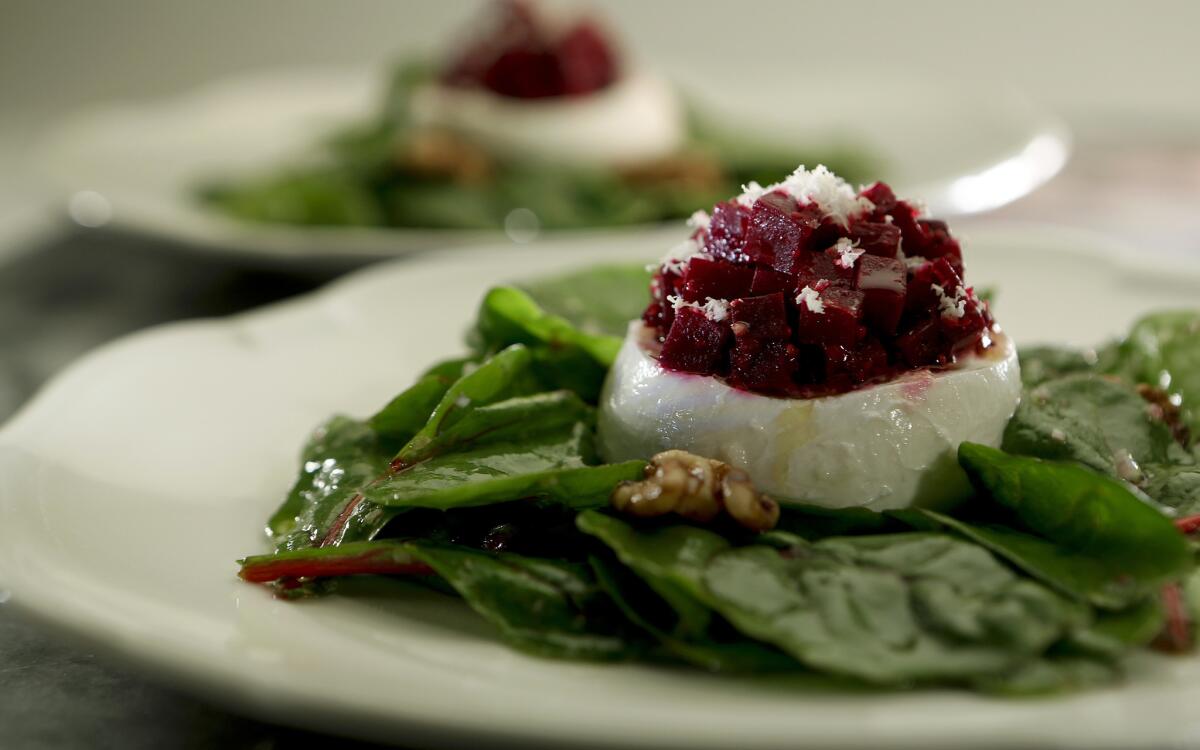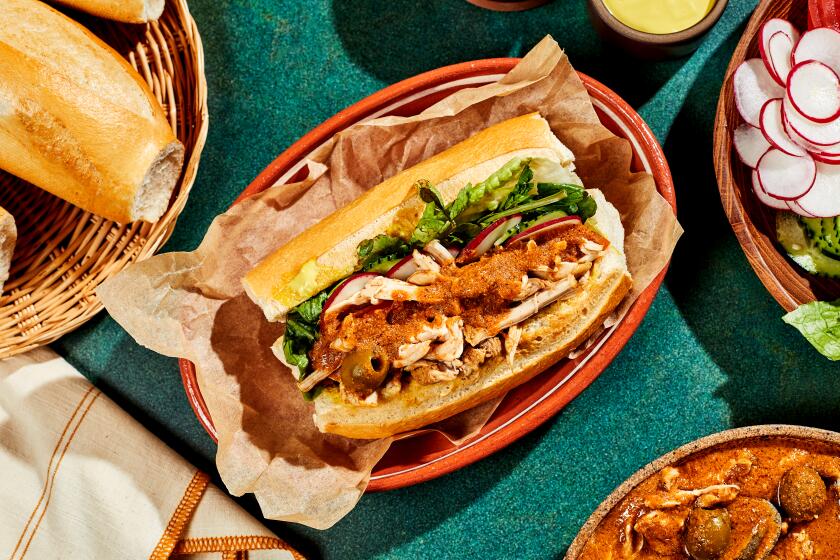Beet and burrata salad

Over the years as a chef, I’ve become fixated with understanding the intricacies of various ingredients, but I’d never given horseradish a second thought until fairly recently, when I became obsessed with the horseradish cream that my friend Suzanne Tracht serves at her restaurant, Jar. I dine there often, and every time I tasted that sauce — which she serves with her famous pot roast and as a dip for the potato chips she offers at the bar, among other things — I was blown away by how strong the burn was from the horseradish. I loved it!
Since, at that time, Suzanne and I used the same produce purveyor, the next time I saw him, I asked him what kind of horseradish Suzanne used. As a cook, I come from a school where fresher is always considered better (and I know Suzanne thinks the same way), so I expected our produce guy to hand me some knobby root of an extra-special, very rare variety of horseradish that would offer me that pungent, up-the-nose quality that made Suzanne’s horseradish cream so special.
“Atomic,” our produce guy said casually, as if I’d know what he was talking about.
“What variety is that?” I asked him.
He walked out to his truck and came back in holding a giant jar.
Before I go on record confessing that my favorite horseradish comes from a jar, I feel like I can at least partially redeem myself by pointing out that it’s not just any jar. Morehouse Foods, the company that makes it, is here in Los Angeles. It makes another horseradish sauce under its own name that is common in grocery stores. But Atomic is a product aimed at the company’s wholesale market, though it is available at select groceries, delis and online. I buy mine at Huntington Meats in the Original Farmers Market.
The more common Morehouse horseradish contains just horseradish and vinegar, but Atomic contains grated parsnips as well, which gives it a slightly sweet flavor. But the ingredient responsible for the eye-watering heat that makes this brand irresistible turns out to have nothing to do with horseradish at all. It’s sort of a secret, listed simply as “natural flavoring,” which, upon some investigation, I learned is mustard oil.
I still appreciate fresh horseradish and use it daily at Osteria Mozza, along with parsley, garlic and lemon zest, to make a spicy gremolata to serve atop braised short ribs. And I love fresh, grated horseradish on a ham sandwich.
And even in dishes where Atomic is the star, I often include fresh horseradish as a supporting player. I grate a layer of fresh horseradish over a beet salad with horseradish vinaigrette and also top a horseradish-infused version of duchess potatoes with a light covering of freshly grated horseradish.
I like how fresh horseradish finishes the flavor of a dish, just like fresh Parmesan finishes a pasta, or a dusting of powdered sugar a pastry. And adding freshly grated horseradish to something like horseradish cream also adds a textural component.
But more than anything, like the flecks of vanilla bean in ice cream or gelato, somehow it’s reassuring just to see the fresh horseradish there. Even if most of the punch does come from a bottle.
Beet dressing
In a medium bowl, whisk together the minced shallots, lemon juice, vinegar, salt and pepper. Slowly whisk in the olive oil, then the mustard. This makes about one-third cup dressing. Cover and refrigerate until needed, up to 5 days. Whisk again to emulsify before using.
Roasted beets
Adjust the oven rack to the middle position and heat the oven to 400 degrees.
To cook the beets, trim and discard the tops of the beets and scrub thoroughly. Pat the beets dry with paper towels and place them in a baking dish large enough to fit them in a single layer. Drizzle the beets with the olive oil, season them with the salt and pepper to taste and toss to coat the beets with the seasonings. Cover the dish with foil and place it in the oven to cook the beets until they can be easily pierced with a knife, about 1 hour. Remove the beets from the oven, and remove the foil, being careful not to burn yourself from the steam that will arise from the baking dish, and set the beets aside until they are cool enough to the touch. Rub the beets with a clean dish towel to remove their skins and cut the beets into one-fourth-inch cubes. Toss with enough dressing to coat.
Salad
In a medium bowl, whisk together the minced shallots, lemon juice, vinegar and salt. Slowly whisk in the olive oil, then the walnut oil. This makes about three-fourths cup dressing for the salad; more than is needed for the remainder of the recipe. Cover and refrigerate until needed, up to 5 days. Whisk again to emulsify before using.
In a large bowl, toss the beet greens and walnuts with enough dressing to barely coat. Taste and adjust the seasonings if desired.
To serve, divide the salad among four plates. Place 2 ounces of burrata (use either one 2-ounce ball with the top of the skin removed or half of a 4-ounce ball) in the center of each plate. Divide the beets, piling them evenly over the cheese (use a large soup spoon to scoop up the beets and press them tightly into the spoon, then invert the spoon carefully over the cheese to mound the beets on top.) Grate fresh horseradish over the top of each and serve immediately.
Get our Cooking newsletter.
Your roundup of inspiring recipes and kitchen tricks.
You may occasionally receive promotional content from the Los Angeles Times.















